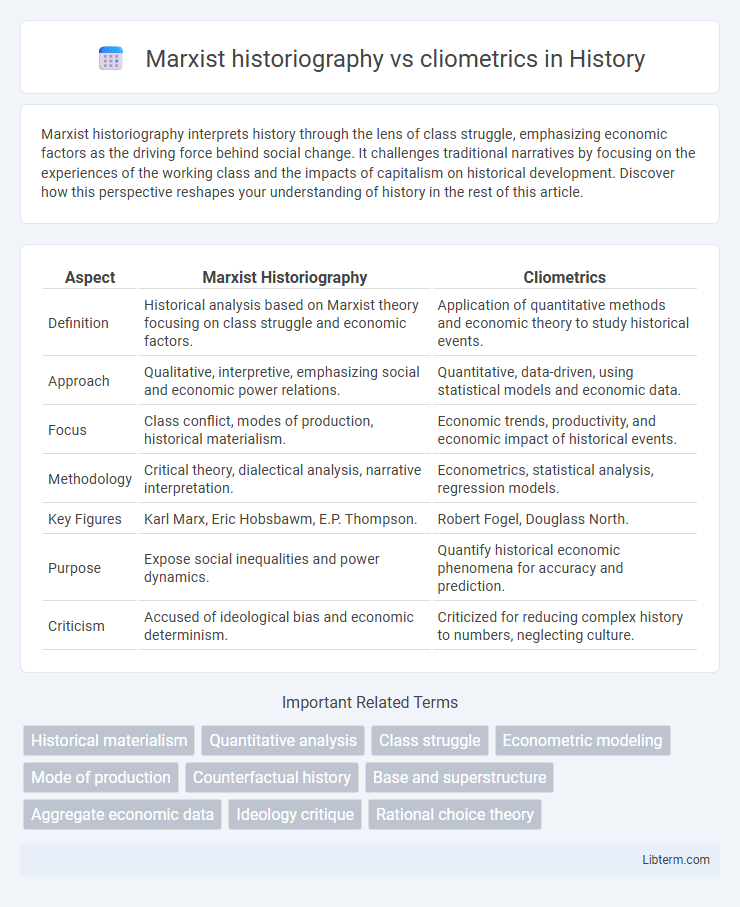Marxist historiography interprets history through the lens of class struggle, emphasizing economic factors as the driving force behind social change. It challenges traditional narratives by focusing on the experiences of the working class and the impacts of capitalism on historical development. Discover how this perspective reshapes your understanding of history in the rest of this article.
Table of Comparison
| Aspect | Marxist Historiography | Cliometrics |
|---|---|---|
| Definition | Historical analysis based on Marxist theory focusing on class struggle and economic factors. | Application of quantitative methods and economic theory to study historical events. |
| Approach | Qualitative, interpretive, emphasizing social and economic power relations. | Quantitative, data-driven, using statistical models and economic data. |
| Focus | Class conflict, modes of production, historical materialism. | Economic trends, productivity, and economic impact of historical events. |
| Methodology | Critical theory, dialectical analysis, narrative interpretation. | Econometrics, statistical analysis, regression models. |
| Key Figures | Karl Marx, Eric Hobsbawm, E.P. Thompson. | Robert Fogel, Douglass North. |
| Purpose | Expose social inequalities and power dynamics. | Quantify historical economic phenomena for accuracy and prediction. |
| Criticism | Accused of ideological bias and economic determinism. | Criticized for reducing complex history to numbers, neglecting culture. |
Introduction to Marxist Historiography
Marxist historiography analyzes historical events through the lens of class struggle, economic factors, and material conditions, emphasizing the role of capitalism and social relations in shaping history. It contrasts sharply with cliometrics, which applies quantitative methods and economic theory to historical data, focusing on statistical analysis and formal modeling to interpret past trends. The introduction to Marxist historiography highlights its foundational principles rooted in dialectical materialism and critiques of capitalist structures as central to understanding historical change.
Foundations of Cliometrics
Cliometrics, grounded in the application of economic theory and quantitative methods to historical analysis, contrasts sharply with Marxist historiography's focus on class struggle and dialectical materialism. The foundations of cliometrics lie in utilizing statistical data and economic models to explain historical phenomena, emphasizing measurable trends over ideological narratives. This methodological framework advances historical understanding by integrating econometric tools to analyze economic history, thereby providing empirical evidence rather than purely theoretical or philosophical interpretations.
Philosophical Underpinnings: Materialism vs. Quantification
Marxist historiography rests on dialectical materialism, emphasizing historical development through class struggle and socio-economic forces shaping human consciousness. In contrast, cliometrics applies quantitative methods and economic theory to historical analysis, prioritizing statistical data and measurable variables to explain historical phenomena. These differing philosophical foundations reflect a divide between a materialist interpretation focused on underlying social relations and a positivist approach seeking empirical validation through numbers.
Key Proponents and Influential Works
Marxist historiography, championed by historians like E.P. Thompson and Eric Hobsbawm, emphasizes class struggle and economic forces in historical analysis, with key works such as "The Making of the English Working Class" and "The Age of Extremes." Cliometrics, led by scholars like Robert Fogel and Douglass North, applies quantitative methods and economic theory to historical data, highlighted by Fogel's "Railroads and American Economic Growth" and North's "Structure and Change in Economic History." Both approaches offer contrasting frameworks: Marxist historiography prioritizes socio-economic conflicts, while cliometrics focuses on statistical modeling and economic efficiency.
Methodological Approaches: Qualitative vs. Quantitative
Marxist historiography employs a qualitative methodological approach, analyzing historical processes through class struggle, economic relations, and ideological contexts to interpret social change. Cliometrics relies on quantitative methods, using statistical analysis and econometric models to examine historical data, aiming to provide empirical evidence for economic and social trends. The fundamental distinction lies in Marxist historiography's focus on interpretive, narrative-driven analysis versus cliometrics' emphasis on data-driven, numerical evaluation.
Sources and Evidence in Historical Analysis
Marxist historiography emphasizes primary sources such as workers' writings, class struggle documents, and economic data reflecting modes of production, prioritizing qualitative analysis to highlight material conditions and social relations. Cliometrics relies heavily on quantitative data from archival records, census statistics, and economic datasets, applying econometric models to uncover patterns and causality in historical events. The divergence in sources--Marxism's focus on ideological and socioeconomic texts versus cliometrics' statistical evidence--shapes fundamentally different interpretations and methodologies in historical analysis.
Class, Economy, and Historical Change
Marxist historiography emphasizes class struggle as the driving force behind economic and social change, interpreting history through the lens of conflicts between ruling and oppressed classes. Cliometrics applies quantitative methods and economic theory to analyze historical data, focusing on economic factors, market dynamics, and institutional changes to explain historical development. While Marxism centers on class relations and exploitation, cliometrics prioritizes empirical economic analysis, often downplaying ideological dimensions of historical transformation.
Critiques and Controversies
Marxist historiography faces criticism for its deterministic focus on class struggle and economic forces, often overlooking cultural and individual agency. Cliometrics, utilizing quantitative methods and econometric models, is challenged for reducing historical complexities to numerical data, potentially ignoring social and ideological contexts. Both approaches spark controversies over methodological biases, with Marxists accused of ideological reductionism and cliometricians criticized for privileging empirical rigor at the expense of narrative depth.
Case Studies: Comparing Impact on Historical Narratives
Marxist historiography emphasizes class struggle and economic factors, as seen in case studies like E.P. Thompson's analysis of the English working class, reshaping narratives around social conflict and economic power dynamics. Cliometrics applies quantitative methods and economic theory to historical data, with Robert Fogel's study of railroads' economic impact revolutionizing traditional views on economic development. Comparing these approaches reveals how Marxist historiography foregrounds ideological frameworks, while cliometrics prioritizes empirical data, collectively enriching understanding of historical processes.
Future Directions in Historical Scholarship
Future directions in Marxist historiography emphasize integrating digital tools to analyze socio-economic class struggles and systemic inequalities more comprehensively. Cliometrics advances by employing machine learning algorithms to enhance quantitative analysis of historical economic data, improving predictive modeling. Emerging trends suggest hybrid methodologies combining Marxist critical theory with cliometric precision to reveal nuanced insights into historical dynamics.
Marxist historiography Infographic

 libterm.com
libterm.com